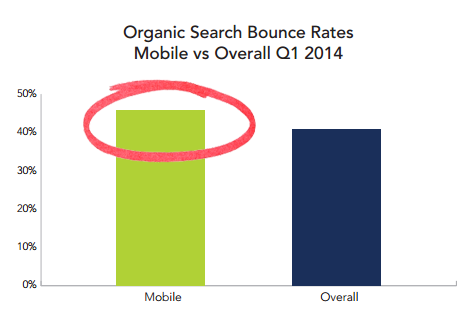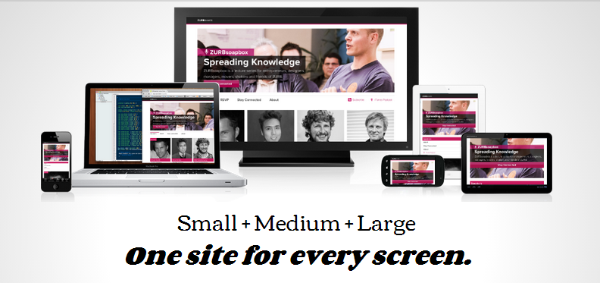We’re 106 days into 2014.
So while it was fun to predict what’s going to happen this year, it’s already taking place.
The Rimm-Kaufman Group (RKG) just released their Digital Marketing Report for Q1 of 2014.
Curious to see what’s impacting your business this year?
We were too…
Bing It
Just kidding.
Google is still driving the majority of traffic.
From the companies RKG surveyed, 82% of organic searches in the USA and 87% of the mobile search visits so far this year were from Google.
Clearly, getting found organically is becoming more important to your business every day.
And one of the best ways to improve how customers find you is by creating relevant content.
The Shift
One of the predictions we made is that we’re going to see a shift in content marketing this year, from a focus on creating content that gets you discovered to creating content that converts.
Because there’s already too much content (every 2 days we’re creating as much information as the amount that existed before 2003), so it’s not just a matter of rising above the noise to generate more traffic, but rising about the noise when it counts to generate targeted traffic.
That’s exactly what we’re starting to see.
And this is where social is coming into play…
Social Media Referrals On The Rise
We spend more time using Facebook on our phones than on our computers, and 6 more times with Twitter.
So it shouldn’t surprise us to learn that more social media referrals are also being generated on the go.
Last year, 22% of the social referrals we made were on our mobile devices. Now it’s over 37%. That’s a 15% increase, and there’s still a lot of 2014 left to go.
What does this mean for your business?
Social media is sending you more customers.
It’s important to track your social mentions, so you can capture the conversation and respond to any comments or questions about your business. And so you can thank people for referring you.
If this isn’t happening enough, check out this post.
What’s even more interesting about social referrals is where they’re coming from.
Facebook is generating over half of them.
Pinterest is following with 25%.
And Twitter is lagging behind at 2%.
Don’t Believe Everything You Read
While it’s easy to deduce from this study that you should clearly use Facebook for your business, because that’s where 54% of social referrals come from, it’s important to keep this in context and understand your business and your customers.
For the companies that RKG surveyed, Facebook is clearly the winning channel when it comes to generating social referrals.
However, content marketing is about knowing your audience.
For example, compared to Facebook, Twitter drives a significant amount of our traffic, and more importantly, leads, customers and partnerships, because that’s where our customers and partners hangout.
All good content strategies have a focus based on their target market. If yours lacks one, consider following this simple guide to put one together.
Mobile Is Crushing It… And You.
We know this.
2014 is the year that mobile will surpass desktop internet use across the globe.
But the real problem is…
Bounce Rates Are Higher On Mobile
Sure, more people are accessing your site on the go, but they’re also more likely to leave when they discover you.
The average bounce rate for mobile organic search traffic was 46% in the first part of 2014, compared to 41% for the same period on desktops.
This is a problem.
Especially since this trend will only continue.
To avoid the trap, make sure your mobile website experience is as good – or better – than your desktop one.
Yes, your site needs to be responsive.
But it also needs to get better at converting on the go, because that’s how more people are discovering you.
This means creating content that’s easy to digest in multiple formats.
For example, while a one or two sentence paragraph may look empty on a big screen, it will look a lot longer on a small one. This is one of the reasons our blog posts are broken into tiny paragraphs – we’re making them easier to digest on the go.
It’s also why we have a lot of headings – because only 16% of us read a post word for word. And I predict that will decrease even further as more of our content (especially blogs) is consumed on the go.
For a quick refresher on how to make your blog mobile friendly, check out this post.
And if you’re unsure about what “being responsive” means for your business, John Polacek put together a great little visualization that explains it all: What The Heck Is Responsive Web Design?
Why Marketing Automation Is Here To Stay
The first 106 days in 2014 have also shown us something else we thought is coming true.
Creating content is a vicious cycle.
As a result, the desire for marketing automation platforms is on the rise.
In fact, 91% of buyers who are evaluating marketing automation software this year are doing it for the first time.
It’s not just the big companies either – 27% of these companies have less than 20 employees and 13% have less than 10.
Does this mean that marketing automation is right for you?
That depends.
On what?
p.s. A big thank you to Rimm-Kaufman Group for putting this study together.
As indicated, the charts in this post are from the RKG Digital Marketing Report Q1 2014. It’s an informative read, specifically their section on Organic Search & Social on pages 14 to 18. Feel free to check out the research in full here.





